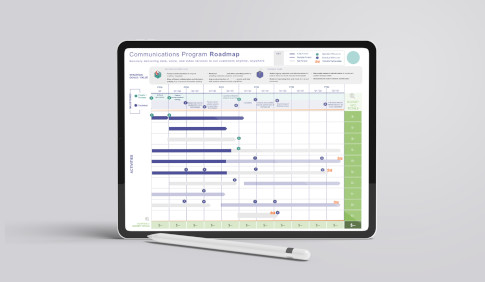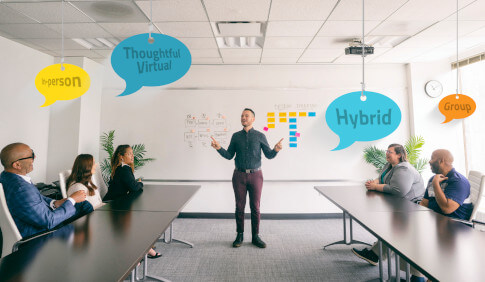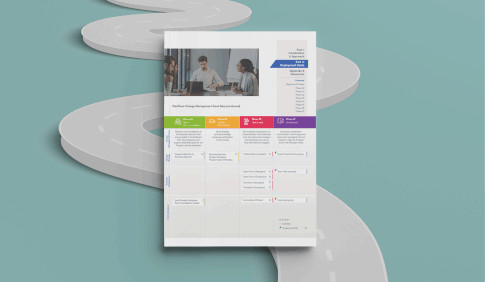Human Centered Design and Today’s Federal Government
What is Human-Centered Design?
Let’s level set. Before we dive into why Human-Centered Design (HCD) is the future of work at federal agencies, we need to define it. Fortunately, my colleague Robyn wrote an entire post doing just that. To summarize, HCD simply means considering the human perspective during all phases of problem-solving. To do so, we center on three principles:
Focus on all people
Find the root problem
Everything is interconnected
When it comes to application for federal agencies, the most important thing to remember is that HCD is a mindset. No matter what problem you’re tasked with solving, it’s where you must start: designing with the human in mind and at the center. Or as we say at The Clearing, “people first.”
What’s Driving the Move Towards HCD for Federal Agencies?
As humans that live in 2021, we’re all demanding more from the products and services that we interact with. We experience good Human-Centered Design on a daily basis. We know what it looks like, feels like – we know it when we see it. For example:
Amazon Prime is designed around modern life, simplifying the human experience by removing the hassles traditionally associated with shopping
Grocery delivery services make it easy to shop, avoid crowds, and save time
Our phones use our digital behaviors to prioritize content that we care about so we see it first
Fortunately for all of us, the federal government has realized they too must consider the individuals they serve when designing their systems, processes, and services. When I go to renew my passport or get my Social Security card updated with a name change, that experience should be as seamless as the ones I have in my everyday life. When federal agencies can’t meet expectations, customers like me get frustrated because we’re having good customer experiences elsewhere.
And now, the stakes are raised with the President’s new Executive Order. The headline of which is music to our CX team’s ears:
Putting the Public First: Improving Customer Experience and Service Delivery for the American People.
But how do you do that as a large federal agency? Well, you start by understanding your customer’s perspective on how they want to interact with your service or tool. This is where Human-Centered Design comes in.
Simple Mechanics, Big Changes
My colleagues and I are currently working with the Personnel & Services Department of a large federal defense agency that wants to make its systems and applications more intuitive and easier to use for its employees (the customer, in this case). Instead of developing new systems and waiting until the application is released to find out if it actually works for the human, they have introduced HCD into the process as early as possible. As a result, they’re getting a better sense of what the customer is really looking for before they make critical decisions (avoiding wasted time, money, and resources).
We are also seeing agencies realize that HCD is a key tool in determining whether or not they should take on a project. Transformation efforts aren’t just about how much it costs or how long it takes to do something anymore. They’re about determining the pain point that a customer or employee is experiencing right now and asking, “does the proposed investment solve that pain point?”
Why it Matters
FOR THE AGENCY: HCD cuts down on wasteful spending, allowing agencies to put more money toward mission-driving activities. How? If you are designing applications or services with the human in mind, you’re getting feedback from real customers on what they’re looking for. It means you’re not wasting time, dollars, and resources building something nobody wants because you started by asking them what they DO want.
Putting the human first also brings equity and accessibility to the forefront, another focus of the current administration. An HCD mindset will help agencies deliver on those priorities by designing applications, systems, and services with all members of the public and their needs in mind.
FEDERAL GOVERNMENT AS A WHOLE: If every agency practiced HCD, the government would operate in fewer silos. Let’s use the name change example again. Human life events are not siloed the way the government is in terms of the agencies that cover all the places you’ll need your name changed. Say I go to get my name on my Social Security card changed. That means I also probably need my name changed on my driver’s license and passport.
If HCD was employed across the entire government, federal and state, it would be the catalyst in figuring out how to better design processes and systems to be more like everyday human interactions. For example, agencies would know if I put in for a name change in one spot that I’ll need it changed in three or four other spots. So instead of having to interact with three systems, they would design a single place for someone to make all those updates at once. Or better yet, make the subsequent changes for me, proactively handling my additional needs
FOR THE TAXPAYER: Think of it like an “easy button.” I don’t know how many different places I need to have my name changed. But if the government is able to prompt me, or take care of it for me, it moves to a level of not just reacting to customer needs but anticipating them. Just like I experience with the non-governmental service providers in my life.
The Clearing and HCD: What’s Next?
We’re already helping three large agencies employ HCD principles into transformation efforts. What we’re focused on is the mindset shift mentioned above. It doesn’t matter if you’re a developer, coder, or executive, each has a role to play in delivering a human-centered experience. At different levels, decisions made by each of those people impacts the customer. Using HCD principles allows us to help clients ensure it delivers the right impact.
We’re also beginning to see HCD as a virtuous cycle, where those designing the system benefit from it just like everyday users. Think about the Personnel & Services systems work we talked about earlier. You can’t escape any government agency without engaging with HR. Employees need to be able to make sure they’re receiving benefits, go up for promotions, check their pension, set up retirement dates, etc. However, working in HR doesn’t preclude you from having to deal with those systems. In this case, those we’re designing the systems and applications with have as much to gain as any other user. It’s that win-win proposition, coupled with the executive focus on customer experience, that will continue to push human-centered design into the federal spotlight.
CX MythBusters: Pizza Parties Increase Employee Experience
I’ve recently been rewatching The Office. If you’re a fan like me, you’re familiar with self-proclaimed “World’s Best Boss” Michael Scott and his frequent and desperate attempts to win the hearts and minds of his employees. Often Michael tempts staff with free food and social events: Pizza by Alfredo and “Movie Mondays.” While Michael means well, his gestures may satisfy his employees in the moment, but not the next day, when he encounters the same disengaged workforce.
While the Dunder Mifflin office is fiction, the reason The Office is popular is because it resonates with so many of us. Practices like free lunches, casual Fridays, or in today’s virtual environment, Zoom happy hours and employee care packages, are not the sole kinds of investments that ensure our employees feel valued and part of an inclusive organization. Employers are not seeing meaningful ROI from these efforts alone, so why spend time and money on small gestures that don’t lead to our desired outcomes?
Offering free lunch is an example of what Harvard Business Review (HBR) calls an adrenaline shot: a short-term, employee engagement effort designed to temporarily boost employee satisfaction. Adrenaline shots feel nice in the moment but provide no lasting impact on the overall, long-term employee experience (EX). According to HBR, “when organizations make real gains…they’re going beyond what engagement scores are telling them to do in the moment… creating a place where people want, not just need, to work each day.” Only when organizations go beyond short-term satisfaction boosters can they reap the rewards of positive EX.
What Does Positive EX Mean for Your Organization?
Greater Financial Returns
According to IBM’s Smarter Workforce Institute’s 2018 report, “The Financial Impact of a Positive Employee Experience,” “Organizations that score in the top 25% on employee experience report nearly three times the return on assets….” and “… double the return on sales compared to organizations in the bottom quartile.” A recent Towers Perrin study found that companies “with the highest percentage of engaged employees collectively increased operating income 19% and earnings per share 28% year to year. Those companies with the lowest percentage of engaged employees showed year-to-year declines of 33% in operating income and 11% in earnings per share.”
Higher Employee Retention Rates
Employee experience also has a direct impact on retaining employees. Gallup’s 2016 Meta-Analysis on The Relationship Between Engagement at Work and Organizational Outcomes found that of the 230 organizations studied, companies scoring high in employee engagement have between 24%-59% less turnover, depending on the industry, compared to those with low employee engagement scores. Multiple studies show that the total cost of losing an employee can range from tens of thousands of dollars to 1.5-2 times their annual salary. No matter which sector you work in, one way to easily increase efficiency is to retain top talent. Investing in employee experience keeps top talent around, engaged, and saves money in the long run.
Higher Customer Satisfaction and Goal Achievement
Finally, beyond financial ROI, Gartner found that “Organizations whose employees are largely satisfied with their experience are 48% more likely to meet organizational customer satisfaction goals, 89% more likely to meet organizational innovation goals, and 56% more likely to meet organizational reputation goals.” Moreover, “employees who are largely satisfied with their experience are 52% more likely to report high discretionary effort and 69% more likely to be a high performer.”
Myth Busted… Companies Should Invest More in EX than Pizza Parties
In order to move the needle forward on employee engagement and benefit from the investment, organizations need to commit to their employees’ long-term experience. Employee experience is a customer experience; from the technology they use to the workspace they use every day. Understanding their journey as a whole is important. It’s time to move beyond focusing only on one-time interactions and free pizza.
Customer Experience Myth #1: CX Can’t be Quantified
Every organization exists and evolves because we, as customers, see value in our lives. In the broadest sense, a customer is anyone who interacts with an organization whether they are an employee, paying for a product/service, or simply seeking information. CX captures the full spectrum of interactions a customer has with an organization across their entire journey and how an individual feels about their experience.
CX is more than just making customers and employees feel good. Let’s dig into a real-life example of CX in action and how my positive experience translates to financial ROI.
Smoke Detector: 1, Lindsey: 0
Last Saturday around 3:00am the smoke detector in my bedroom began chirping. Groggy, I climbed onto a chair to change the battery. When I stepped off the chair, I landed wrong, and my ankle rolled. When I woke up later that morning, my foot was severely swollen, I couldn’t walk, and I was in pain. Concerned I might have broken my ankle, I was anxious to see a doctor in fear the issue could get worse if left untreated.
Not being able to walk makes walking into a doctor’s office…difficult. Lucky for me, my primary care provider has a very user-friendly phone app which gave me the option to schedule a video visit with a member of the medical team. Video visits are offered 24/7, and the expected wait time is five minutes or less. After requesting the video call, it took about four minutes for a nurse practitioner to greet me and begin assessing my ankle.
Ultimately my ankle wasn’t broken, which the nurse practitioner was able to diagnose by simply asking me to show her my ankle by flipping my phone camera around. By the time I hung up, she had not only eased my concerns, she also gave me suggestions on treatment via a recovery packet sent through the app’s message center. To monitor my recovery, I sent photos of my ankle using the message center until the medical team felt satisfied with my progress. Quickly and without a lot of effort, I was able to get a diagnosis, receive a treatment plan, and track recovery progress without ever leaving my couch.
CX = Financial ROI
As a result of my experience, my medical provider has one very satisfied customer, but how does this experience translate into financial ROI for organizations and how can this value be quantified? In the case of my medical provider, it’s from positive-word of mouth and Net Promoter Score (NPS), a simple tool used to indicate how likely I am to recommend their services to someone else. My positive experience increases the likelihood that I’ll share this experience with a few of my friends who may decide to switch medical providers, increasing my doctor’s customer base and overall company revenue. More satisfied customers mean less customer complaints, and fewer customer complaints reduces expenses in an organization’s time, effort, and resources spent needing to satisfy each individual grievance.
My positive experience also means I’m now a customer for life. My provider was able to successfully retain me as a customer and will continue to generate revenue from future interactions. Customer experiences like this impact my loyalty and open me up for future sales and lowers my price sensitivity. Customers are not always looking for the best deal, they are looking for the organization who can meet their needs with the most accuracy, least amount of effort, and through an enjoyable experience, even if that means paying a premium.
Finally, the fact that I was able to connect via video chat with a provider means that there was one less trip to a brick and mortar doctor’s office. My nurse practitioner supported me from her home, resulting in a savings of overhead costs for the medical provider and personal savings on travel for the employee.
Myth Busted… CX Value Can Be Quantified!
In a 2019 study, companies focused on CX generated a total return of 45 points higher than the S&P 500 Index average over an 11 year period. Conversely, companies slower to adopt CX practices were 76 points lower in return than the broader market. Additionally, Harvard Business Review found companies with a Customer Experience Score of 10 (on a scale of 1-10) had an annual revenue per customer that was nearly 2.5x higher than a company receiving a Customer Experience Score of 1.*
Organizations exist to fill the unmet needs of their customers. Companies can no longer afford to avoid adopting a CX focus if they wish to remain competitive and profitable. As the data shows, CX is not just about making your customers feel good; your customers’ perceived interactions with your company contribute not only to their overall experience but to the health of your organization as a whole.
What have you heard about CX that needs myth busting? Drop me an email and let me know what topics you’d like us to dig into next.
Need to Make A Decision? Step 1: Check Your Biases
As leaders of our organizations and teams, we are faced with the need to make critical decisions every day: Which candidate do I trust to hire? What new markets should I be looking to invest in? Do the current processes in place still support the needs and the work of my business? On their face, these decisions can be difficult to make. When you also consider the number of unconscious biases at play (there are 80 known biases that impact a human’s ability to make cognitive choices!) making the “right” decision can feel like a near-impossible task.
At the second annual Work Better Day conference, participants focused on the task of decision making. We explored some common biases that can impact leaders’ abilities to make good decisions and heard from a panel of experts on how to better recognize and mitigate the effects of bias:
Age Bias: You’re at your weekly staff meeting in the large conference room where your employees are offering their suggestions on how best to pursue a potential new client. When your newest employee, a Millennial, speaks up and offers her insight, you may unconsciously and unintentionally think to yourself, “She is so young, what could she know anyway?” If this thought crosses your mind, your thinking might be influenced by age bias. Leaders display an age bias when they are more likely to listen to the ideas of seasoned or more experienced employees, regardless of the quality of the idea.
Impact: Age bias can cause leaders to disregard good ideas and can leave younger employees feeling discouraged and without a voice.
Potential Mitigation: Try asking for suggestions, feedback, and ideas from your staff virtually and anonymously before following up with the owner of the suggestion so you can allow yourself to truly hear the idea on its own merits, and not be biased by the age or level of experience of the employee from whom the idea was generated.
Groupthink: You’re in the same weekly staff meeting discussing the potential new customer. As the leader in the room, you kick off the conversation and offer your opinion on the matter first. Suddenly, all of the heads in the room start to nod, and no more suggestions or ideas are offered. This is an example of groupthink. First used by social psychologist Irving L. Janis, groupthink “refers to a psychological phenomenon in which people strive for consensus within a group.” In order to “keep the peace” and so as not to disrupt the “uniformity of the crowd,” people will often abandon their own thoughts to adopt and accept the opinions of the group. This bias can show up even stronger when that voiced suggestion is coming from the head of the table.
Impact: Innovation is squashed and diversity of thought cannot be capitalized on.
Potential Mitigation: As the leader, you may consider sitting out for these conversations and setting up separate task forces for these brainstorming sessions, so as to lessen the intimidation or influence your opinions may have on the group. You also may consider assigning at least one employee in this taskforce to play the role of the “devil’s advocate” and help the group remain critical of its ideas.
Confirmation Bias: Seated in the same meeting, you have a belief that because this potential new customer is a newly-established organization, they will be a less reliable partner than a longer-tenured peer. When your employees in the meeting start presenting their data and findings that prove otherwise, you may unconsciously start disregarding these facts, telling yourself they must be wrong and begin to only listen to the insights that further confirm your original belief. As outlined in the FACTS, STORIES, BELIEFS PRIME, beliefs shape the facts we listen to and the stories we tell about them.
Impact: Entrenched beliefs that do not evolve as new information is presented can result in ill-informed decision-making.
Potential Mitigation: Actively seek out data and information that disagrees with your beliefs as a way to challenge them. You should seek to understand the initial conclusion you have reached, the data you have used to reach it, and the limitations or biases that may influence that data. Finally, enroll a trusted few to call out your blind spots when it comes to specific beliefs.
Be of service to both your business and yourself by staying aware of these biases. Cultivate your ability to spot them when they present themselves during times of decision making. Knowledge is power, and the more knowledgeable you can be of the unconscious biases that may be affecting how you make decisions, as well as potential ways to mitigate these biases, the better your decisions can be.
At The Clearing, we help leaders continuously challenge themselves to grow and become better decision-makers. Through the use of frameworks like The PRIMES and training programs such as our Leadership Development Program, we help leaders understand and build upon their strengths, while also acknowledging and working to address their weaknesses. To learn more, contact us.




